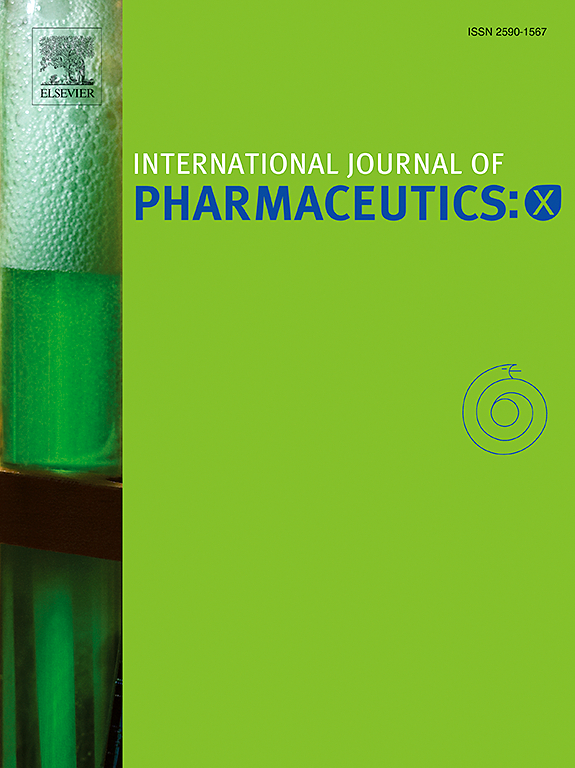Development, characterization, and in vitro evaluation of poly(ethylene oxide)-block-poly(ε-caprolactone)-α-tocopheryl succinate micelles as a novel nanocarrier for rapamycin delivery
IF 5.2
2区 医学
Q1 PHARMACOLOGY & PHARMACY
引用次数: 0
Abstract
Rapamycin holds significant therapeutic potential for various diseases; however, its clinical application is limited by several formulation challenges, primarily its extremely low aqueous solubility (2.6 μg/mL). To address this, nanoparticle-based delivery systems have emerged as a promising strategy to enhance solubility and enable sustained drug release. Currently, Fyarro® (Aadi Bioscience, Inc.), an albumin-bound nanoparticle formulation, is the only FDA-approved injectable rapamycin product. In this study, we aimed to develop and evaluate novel poly(ethylene oxide)-block-poly(ε-caprolactone)-α-tocopheryl succinate (PEO-b-PCL-α-TS) micelles and assess their potential as a delivery system for rapamycin. PEO-b-PCL copolymers with varying PCL/PEO ratios were prepared via ring-opening polymerization and modified by α-TS conjugation, as confirmed by 1H NMR, GPC, XRD, DSC analyses. The optimum rapamycin-loaded micelles (PEO2000-b-PCL4000-α-TS) exhibited nano-sized particles (< 22 nm) with a narrow polydispersity index (<0.29), high drug encapsulation efficiency (≥92 %), and enhanced solubility (>1.3 mg/mL). Stability studies demonstrated that encapsulation protected rapamycin from degradation, maintaining over 90 % drug retention for three months at 4 °C, while in vitro release studies showed sustained release, with 50 % of rapamycin released from PEO2000-b-PCL4000-α-TS micelles over 72 h. In vitro cytotoxicity assays revealed anticancer activity against lung carcinoma epithelial cells (A549), and the human colon adenocarcinoma cell line (HCT116). Minimal toxicity (≥70 % viability) was observed in normal human fibroblast cells (HFF1). These results point to the potential of PEO-b-PCL-α-TS micelles as a promising nanocarrier system, offering improved rapamycin solubility, enhanced stability, sustained release, and effective anticancer activity.
聚环氧乙烷-嵌段聚(ε-己内酯)-α-琥珀酸生育酚胶束作为雷帕霉素纳米载体的研制、表征和体外评价
雷帕霉素对多种疾病具有显著的治疗潜力;然而,其临床应用受到几个配方挑战的限制,主要是其极低的水溶性(2.6 μg/mL)。为了解决这个问题,纳米颗粒为基础的递送系统已经成为一种有前途的策略,以提高溶解度和实现持续的药物释放。目前,Fyarro®(Aadi Bioscience, Inc.)是一种白蛋白结合纳米颗粒制剂,是唯一获得fda批准的可注射雷帕霉素产品。在本研究中,我们旨在开发和评估新型聚(环氧乙烷)-阻断聚(ε-己内酯)-α-生育酚琥珀酸酯(PEO-b-PCL-α-TS)胶束,并评估其作为雷帕霉素递送系统的潜力。采用开环聚合法制备了不同PCL/PEO比例的PEO-b-PCL共聚物,并采用α-TS偶联改性,经1H NMR、GPC、XRD、DSC分析证实。最佳负载雷帕霉素胶束(PEO2000-b-PCL4000-α-TS)呈现纳米级颗粒(<;22 nm),具有较窄的多分散指数(<0.29),较高的药物包封效率(≥92%)和增强的溶解度(>1.3 mg/mL)。稳定性研究表明,包封保护雷帕霉素不被降解,在4°C下保持90%以上的药物保留率,而体外释放研究显示持续释放,在72小时内,50%的雷帕霉素从PEO2000-b-PCL4000-α-TS胶束中释放。体外细胞毒性实验显示,雷帕霉素对肺癌上皮细胞(A549)和人结肠腺癌细胞系(HCT116)具有抗癌活性。在正常人成纤维细胞(HFF1)中观察到最小毒性(≥70%存活率)。这些结果表明PEO-b-PCL-α-TS胶束作为一种有前途的纳米载体系统,具有改善雷帕霉素溶解度、增强稳定性、缓释和有效抗癌活性的潜力。
本文章由计算机程序翻译,如有差异,请以英文原文为准。
求助全文
约1分钟内获得全文
求助全文
来源期刊

International Journal of Pharmaceutics: X
Pharmacology, Toxicology and Pharmaceutics-Pharmaceutical Science
CiteScore
6.60
自引率
0.00%
发文量
32
审稿时长
24 days
期刊介绍:
International Journal of Pharmaceutics: X offers authors with high-quality research who want to publish in a gold open access journal the opportunity to make their work immediately, permanently, and freely accessible.
International Journal of Pharmaceutics: X authors will pay an article publishing charge (APC), have a choice of license options, and retain copyright. Please check the APC here. The journal is indexed in SCOPUS, PUBMED, PMC and DOAJ.
The International Journal of Pharmaceutics is the second most cited journal in the "Pharmacy & Pharmacology" category out of 358 journals, being the true home for pharmaceutical scientists concerned with the physical, chemical and biological properties of devices and delivery systems for drugs, vaccines and biologicals, including their design, manufacture and evaluation. This includes evaluation of the properties of drugs, excipients such as surfactants and polymers and novel materials. The journal has special sections on pharmaceutical nanotechnology and personalized medicines, and publishes research papers, reviews, commentaries and letters to the editor as well as special issues.
 求助内容:
求助内容: 应助结果提醒方式:
应助结果提醒方式:


